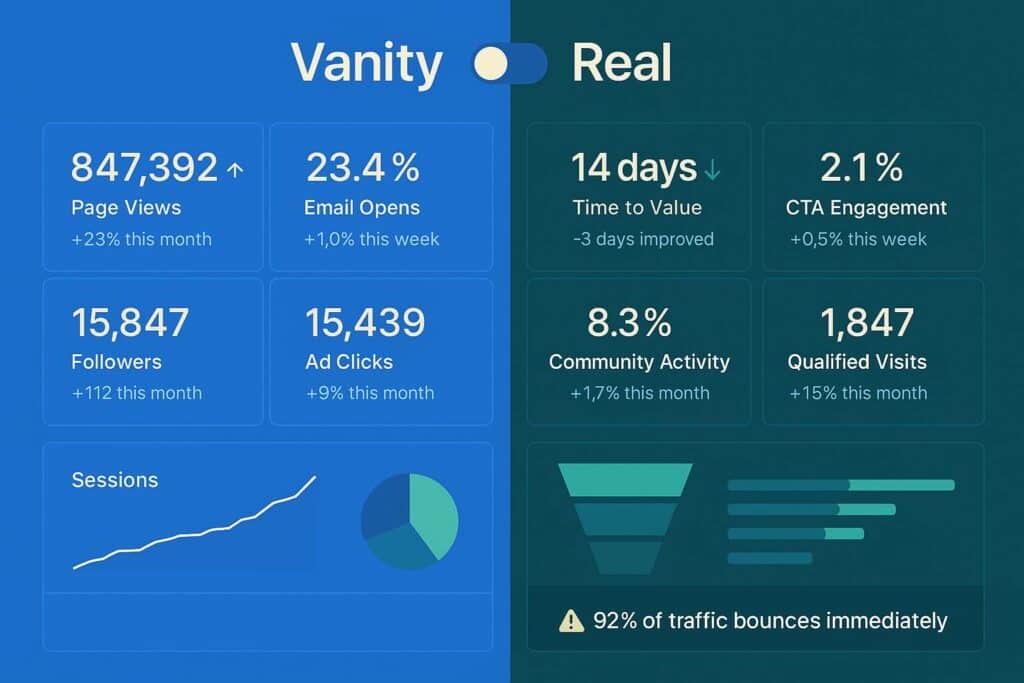Reading time: 5 minutes
Part 2 of the July blog series on The Growth Ethos. Subscribe to follow it.
The most effective marketers are letting go of surface-level metrics and asking deeper questions about value and momentum in 2025.

“If your metrics look strong but your growth feels fragile, you’re probably tracking the wrong signals.”
1. Time’s up for vanity metrics
We all know them: bounce rate, impressions, total followers, and CTRs without context. They make dashboards look impressive, but they rarely tell you what’s truly working.
Vanity metrics give the illusion of progress. Behind the surface, they often hide bigger issues:
- Leads that never convert
- Followers who never engage
- Traffic that never returns
Forward-thinking growth teams, especially in B2B and purpose-driven businesses, are shifting toward metrics that reflect value, momentum, and alignment.
2. What makes a metric “vanity”
It’s not always about the metric itself; it’s about what it tells you (or doesn’t).
A metric becomes vanity when:
- It doesn’t influence decisions
- It lacks context or strategic value
- It grows while your business stalls
“10,000 pageviews may look good on paper. However, if 92% of the traffic bounces and only 0.3% converts, that traffic is essentially noise.”
3. What to track instead
Here’s what growth-conscious marketers are tracking instead in 2025:
| Old Metric | New Metric |
|---|---|
| Pageviews | Time-to-Value (TTV) – how fast users get value |
| Email Opens | CTA Engagement or Replies – actual interaction |
| Follower Count | Community Activity Rate – % of followers engaging monthly |
| Ad Clicks | Cost per Qualified Visit – not just any click |
| Sessions | Returning User Rate – who comes back and why |
4. Metrics with meaning (especially for purpose-driven brands)
To go deeper, here are five high-signal, value-aligned metrics you should consider building into your strategy:
a. Activation rate
How many users reach their first meaningful milestone?
Example: Downloading a carbon-saving tool or completing a product demo.
b. Referral-to-signup ratio
Are users bringing others with them?
This is one of the most powerful signals of real product affinity.
c. Time-to-impact
How quickly can someone see results or value from your offer?
Shorter time = higher retention and trust.
d. Values-aligned lead %
What portion of your leads match both your ICP and your mission?
A simple lead scoring system can help track this.
e. Community contribution rate
Who isn’t just consuming, but actively sharing, commenting, or co-creating with you?
5. The bigger picture: why this shift matters
Tracking more meaningful metrics isn’t just about efficiency but clarity and alignment.
If you’re building a mission-driven brand, surface-level performance isn’t enough. Global data from PwC shows that consumers are willing to pay an average of 9.7% more for sustainably sourced products. This reinforces that sustainability-aligned growth isn’t just ethical, it’s commercially strategic.
You need indicators that tell you:
- Are we delivering something people want?
- Are we attracting the right users?
- Are we building long-term momentum or chasing short-term peaks?
Better metrics lead to better questions, better alignment, and better growth.
WHAT’S NEXT IN THIS SERIES
This is part 2 of The Growth Ethos, a 10-part blog series on how to grow with clarity, intention, and impact in 2025.
Coming next:
→ How to Build a Sustainable Growth Engine Without Burning Budget (or the Planet)
LET’S BUILD SOMETHING BETTER
If you’re rethinking how growth should look—more intentional, more ethical, more effective—this series is for you.
📬 Subscribe to the newsletter to get each new post as it drops, directly to your inbox.